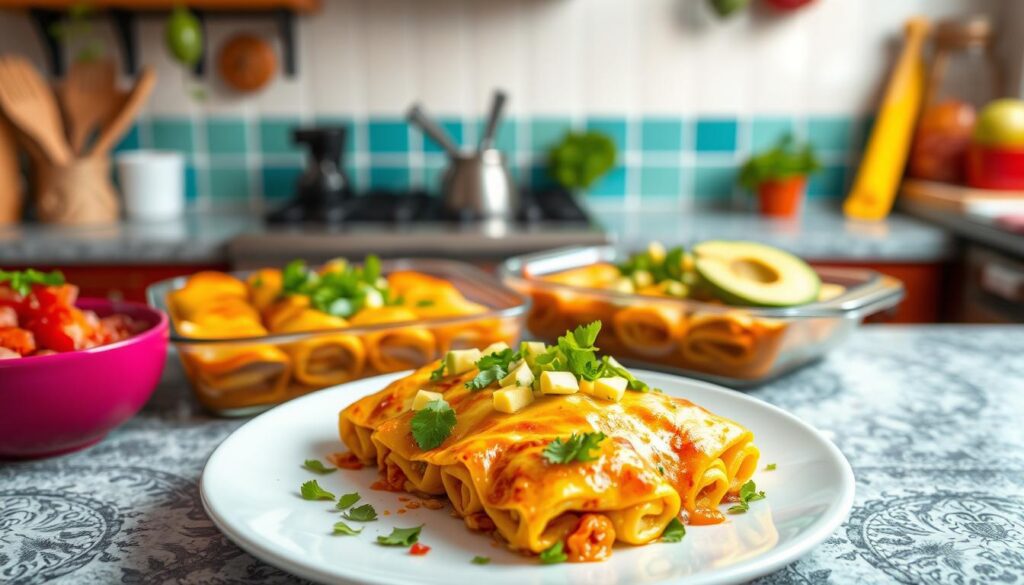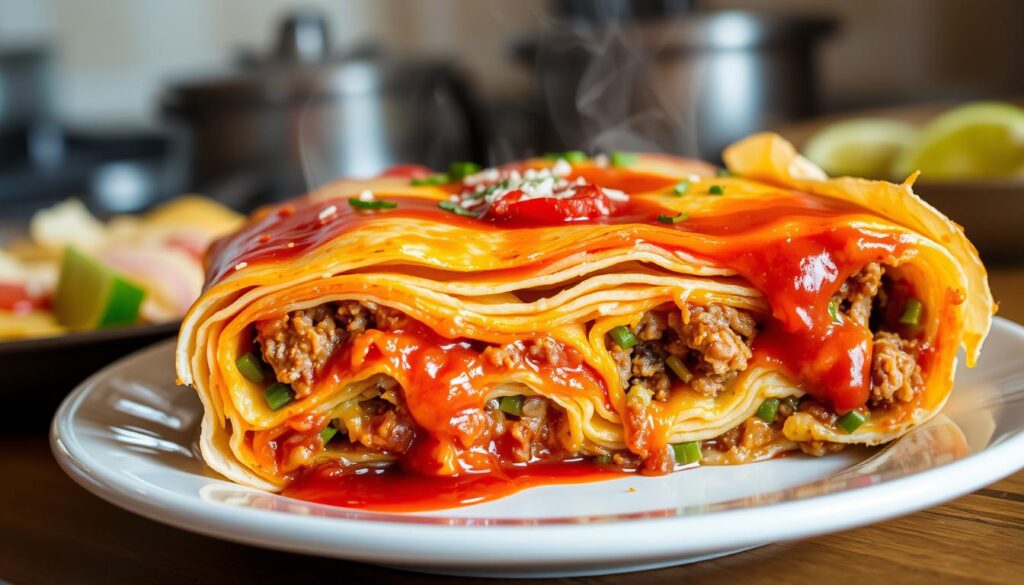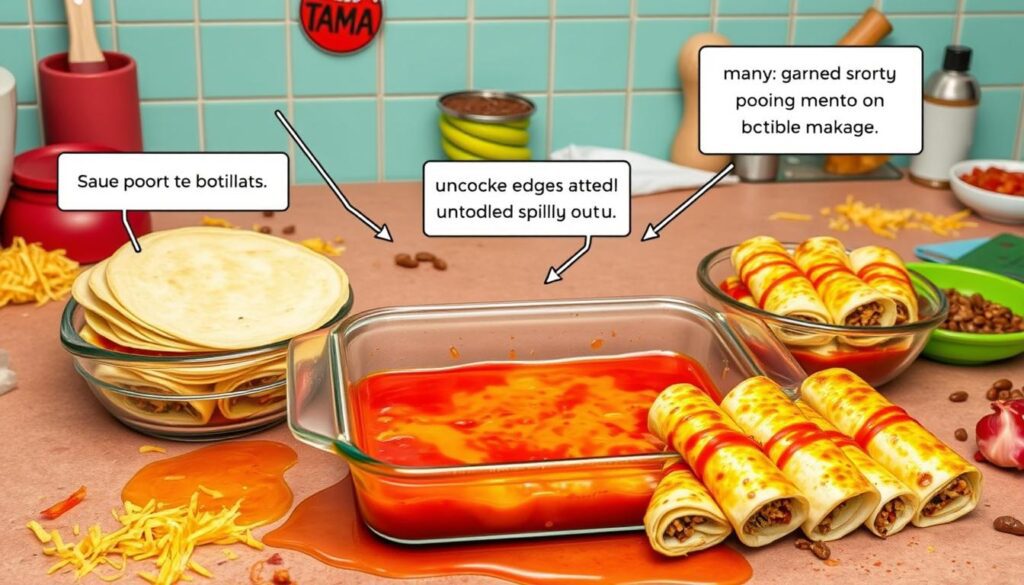Enchiladas are a beloved dish in Tex-Mex cuisine. But, many cooks struggle with a common problem—sogginess. Rebecca Ragland and others have shared their struggles with overcooked parts or too much sauce.
It’s important to understand why enchiladas can become mushy. This knowledge is key for anyone wanting to perfect this dish. In this article, we’ll share cooking tips to help you avoid soggy enchiladas. You’ll also learn how to make your boulders enchilada recipe stand out.

Key Takeaways
- Corn tortillas are ideal for enchiladas, maintaining structure when rolled.
- Frying tortillas for ten seconds on each side creates a barrier against excessive sauce absorption.
- Homemade enchilada sauce typically yields better results than store-bought varieties.
- Coating tortillas in sauce before filling helps to evenly distribute flavors.
- Limit filling to 2 to 3 tablespoons per tortilla to prevent tearing.
- Only spread about 1 cup of sauce at the bottom of the baking dish to avoid sogginess.
Understanding Enchiladas and Their Structure
Enchiladas are filled tortillas with tasty enchilada ingredients like meat, cheese, and veggies. Knowing the enchilada structure is key to a great taste and texture. Corn tortillas are best for their strong flavor and durability compared to flour tortillas.
Building enchiladas involves several important parts:
- Tortillas
- Fillings
- Sauce
- Baking method
Each part must be balanced to meet taste and texture needs. For traditional enchiladas, yellow corn tortillas are best. They’re strong and can hold fillings well, especially when layers are involved.

In New Mexico, stacked enchiladas are popular for their easy making. They mix ground beef, red chile sauce, and cheese for a tasty blend. Knowing how these parts work together helps cooks make standout dishes that stay true to tradition.
| Component | Details |
|---|---|
| Tortillas | Preferably yellow corn for sturdiness and flavor. |
| Fillings | Options include ground beef, cheese, and other vegetables. |
| Sauce | Red chile sauce or enchilada sauce recommended for authenticity. |
| Baking Method | Bake at 375°F for 20-25 minutes until bubbly. |
Learning the enchilada structure is a great start for making both classic and new enchilada recipes. Knowing how to layer flavors, keep moisture, and get the right texture can make any enchilada special.
Common Mistakes When Making Enchiladas
Making delicious enchiladas needs careful attention. Many enchilada mistakes can ruin the dish, especially the texture. One big mistake is using too much sauce. Too much sauce makes the enchiladas mushy, which is not good.
Another common error is not preparing tortillas right. Recipes often say to fry tortillas for 8 to 10 seconds on each side. This makes them taste better and helps them not get too soggy when you add sauce.
Also, don’t overfill tortillas. Too much filling makes them messy and hard to eat. It’s important to balance the ingredients so the filling is just right. This way, the enchiladas roll well and don’t burst.
Instead of frying, try warming tortillas in the oven with a little oil. This method works well and is healthier. Also, make sure not to add too much salt to the beans. Too much salt can ruin the taste of your enchiladas.

The Importance of Tortillas in Enchiladas
Tortillas are key to making great enchiladas. Corn tortillas are often the top choice. They come from Masa Harina and have lots of fiber, keep moisture in, and taste nutty. Since the 1500s, corn tortillas have been a staple in Mexico, keeping their taste and texture.
It’s important to pick the right tortillas for enchiladas. Corn tortillas are better because they don’t break or leak when baked. Flour tortillas are bigger and easier to roll but don’t hold up as well.
To make tortillas better, you can fry them briefly. This helps them keep the sauce out, so enchiladas stay tasty and not soggy. This shows how important tortilla properties are for a great enchilada.
| Property | Corn Tortillas | Flour Tortillas |
|---|---|---|
| Size | Smaller | Larger |
| Flavor | Nuttier | Milder |
| Texture | Holds shape well | More prone to breaking |
| Moisture Retention | Better | Lesser |
| Dietary Considerations | Gluten-free | Contains gluten |
Knowing the differences between corn and flour tortillas helps you make better enchiladas. Whether you choose corn or flour, using their unique qualities will make your dish delicious every time.
Why Do My Enchiladas Turn to Mush?
Many home cooks struggle with soggy enchiladas. This problem often comes from too much sauce or the wrong tortillas. Fixing these issues can make your enchiladas better and more enjoyable.
Over-saturating With Sauce
Too much sauce can make enchiladas mushy and unappealing. When there’s too much sauce, tortillas soak up too much moisture. This makes them lose their firmness.
It’s important to use just enough sauce. You want to flavor the dish without making it soggy. The right tortillas help keep the dish firm, but too much sauce can ruin this.
Using the Wrong Type of Tortillas
The type of tortillas you use matters a lot. Corn tortillas are best because of their taste and strength. Flour tortillas, while common in some places, can get too soft with too much moisture.
Choosing the right tortillas helps them hold up to filling and sauce. Warming tortillas before using them makes them more pliable. This makes your meal better and more fun to eat.
How to Prepare Tortillas Properly
Getting tortillas ready right is key to making tasty enchiladas. You need to fry them and coat them well. This keeps them from getting soggy and boosts their taste.
Frying Tortillas for Optimal Texture
Frying tortillas is important for their texture. You fry each one in hot oil for about 10 seconds on each side. This makes them firm and less likely to soak up too much sauce.
While corn tortillas are often used, you can choose between corn and flour. It’s all about what you like best.
Coating Procedures for Tortillas
Coating tortillas is crucial for flavor and moisture balance. After frying, dip both sides in enchilada sauce. This spreads the sauce evenly and keeps the tortillas from getting soggy.
Also, put sauce on top of the filling, not at the bottom. This helps keep the tortillas firm. These steps make your enchiladas more enjoyable.
| Preparation Method | Benefits |
|---|---|
| Frying Tortillas | Prevents tearing and sogginess, maintains structure |
| Warming Tortillas | Alternative to frying, adds heat without excessive moisture |
| Dipping in Sauce | |
| Placing Sauce on Top | Helps to maintain tortilla texture |
Choosing the Right Sauce for Your Enchiladas
Choosing the right sauce is key to making great enchiladas. A good sauce balances flavors and texture. Making your own enchilada sauce lets you control the taste and ingredients.
Store-bought sauces are quick but often lack flavor. You can also improve store-bought sauce to save time and still taste great.
Options for Homemade Enchilada Sauce
Making your own enchilada sauce is worth the extra time. A simple recipe makes about 2 cups of sauce in under ten minutes. You’ll need:
- 3 tablespoons of olive oil
- 3 tablespoons of flour (for thickening)
- 1 tablespoon of ground chili powder
- 2 cups of vegetable broth (as the base)
- Optional spices like cumin, oregano, and cinnamon
You can adjust the spice level to your liking. Homemade sauce is healthier and can be stored for up to 5 days or frozen for 3 months.
Enhancing Store-Bought Sauce
Improving store-bought sauce is a quick way to make it better. Add:
- 2 tablespoons of butter for richness
- 1-2 tablespoons of flour for thickening
- A splash of chicken broth for depth
- Extra spices like cayenne or smoked paprika for flavor
These tweaks make the sauce more flavorful. Simple changes can make a big difference in taste without a lot of effort.
Perfecting the Filling for Your Enchiladas
Making the perfect enchilada filling takes a lot of care. It’s not just about taste, but also about how it holds up. Getting the filling right means balancing flavors and controlling how much you use.
Balancing Flavors and Ingredients
Enchilada filling should have a mix of tastes and textures. Adding shredded chicken, black beans, and green chiles makes it rich. A bit of cheese adds creaminess, making it more interesting.
Spices are key to bringing out the savory and spicy flavors. They make the filling taste like it’s from a real Mexican kitchen.
Portioning the Filling Correctly
How much filling you use is very important. Using 2 to 3 tablespoons per tortilla keeps it from getting too full. This way, the tortilla stays intact and doesn’t get soggy.
Following this rule makes sure every bite is perfect. It’s a small effort for a big reward.
Baking Techniques to Avoid Sogginess
The baking process greatly affects the texture of enchiladas. Using the right layering techniques and covering with sauce properly can prevent sogginess. Here are some effective methods to keep your enchiladas crispy and intact while baking.
Layering and Placing Your Enchiladas
Start with corn tortillas for enchiladas. They keep their shape well and don’t break easily. Fry each tortilla for about 10 seconds on both sides. This step helps them stay crispy and not too soggy.
Place the enchiladas seam side down in the baking dish. Put about 1 cup of enchilada sauce at the bottom for moisture. Fill each tortilla with 2 to 3 tablespoons of filling to avoid overstuffing.
Covering With Sauce Wisely
When covering the enchiladas with sauce, be careful not to overdo it. Too much sauce can make them soggy. Use 2 to 3 cups of sauce on top for flavor without excess moisture.
By using the right layering and sauce management, you can bake enchiladas perfectly. These steps help avoid sogginess and ensure a great texture.
| Technique | Description | Benefits |
|---|---|---|
| Frying Tortillas | Quickly fry corn tortillas for 10 seconds on each side. | Creates a barrier preventing excess sauce absorption. |
| Layering | Place tortillas seam side down and spread a thin layer of sauce at the bottom. | Maintains structure and enhances flavor without pooling moisture. |
| Controlled Saucing | Use 2 to 3 cups of sauce on top of the filled enchiladas. | Avoids sogginess by providing just enough moisture. |
Expert Tips for Improving Enchilada Texture
To get a great enchilada texture, start with two important steps. Check the tortilla’s freshness and store leftovers right. These tips will make your enchiladas taste better and stay good for longer.
Testing Tortilla Freshness
Fresh tortillas are key for a perfect enchilada texture. Old tortillas can fall apart, ruining the look and taste. Here’s how to check if tortillas are fresh:
- Visual Inspection: Look for signs of age such as discoloration or cracks.
- Touch Test: Fresh tortillas feel soft. If they’re hard, they’re too old.
- Heating: Warming cold tortillas in the microwave or frying them quickly in olive oil makes them better for rolling.
Storing Leftover Enchiladas Properly
Storing leftovers right keeps the enchilada texture and flavor. Here are some tips for home cooks:
- Put leftover enchiladas in an airtight container to keep moisture in.
- Refrigerate them quickly to keep them fresh and prevent spoilage.
- For longer storage, freeze the enchiladas. They can be reheated well and stay tasty.
By following these expert tips on tortilla freshness and storing leftovers, you’ll enjoy better enchiladas. These steps ensure your enchiladas stay delicious, whether they’re just made or reheated.
Conclusion
Learning to make great enchiladas starts with a few key steps. First, choose the right tortillas. Corn tortillas are best because they add flavor and texture.
Frying the tortillas before filling them helps keep them firm. This way, every bite stays delicious and intact.
The sauce you use is also very important. Making your own enchilada sauce is a great idea. It tastes better and blends well with the fillings.
When adding sauce, start with a little at the bottom. Then, cover the enchiladas with a lot of sauce. This keeps them moist but not too soggy.
Finally, baking your enchiladas right is key. Preheat your oven and let them rest after baking. These steps help you make a meal that’s both satisfying and enjoyable.
By following these tips, you can make enchiladas that taste just like your favorite restaurant’s. It’s a rewarding and fun cooking experience.
FAQ
Why do my enchiladas become soggy?
Soggy enchiladas can happen when you use too much sauce or overcook them. Also, using the wrong tortillas can cause it. To fix this, use corn tortillas and just the right amount of sauce.
What type of tortillas should I use for enchiladas?
Corn tortillas are best for enchiladas. They taste great and don’t break easily. This makes them better than flour tortillas for avoiding sogginess.
How can I prevent my enchiladas from breaking?
To stop breaks, warm your tortillas before filling them. A quick dip in oil makes them stronger. This helps them keep their shape and resist sauce.
What is the best method for preparing enchilada sauce?
Making your own enchilada sauce lets you control the taste and thickness. If you’re short on time, you can also improve store-bought sauce with butter and chicken broth.
How much filling should I use in my enchiladas?
Use about 2 to 3 tablespoons of filling per tortilla. This keeps them from getting too full and soggy.
What baking techniques can avoid soggy enchiladas?
To avoid sogginess, layer your enchiladas with the seam side down. Use just a little sauce on top. This helps control moisture while baking.
How should I store leftover enchiladas?
Keep leftovers in an airtight container in the fridge. This keeps them fresh and prevents sogginess. They’ll taste great when you reheat them.
What common mistakes should I avoid when making enchiladas?
Don’t use too much sauce, forget to fry the tortillas, or overfill them. Avoiding these mistakes will make your enchiladas better.
What fillings work well in enchiladas?
Choose fillings that mix savory, spicy, and creamy flavors. Shredded chicken, beef, beans, and cheese are all great options.

